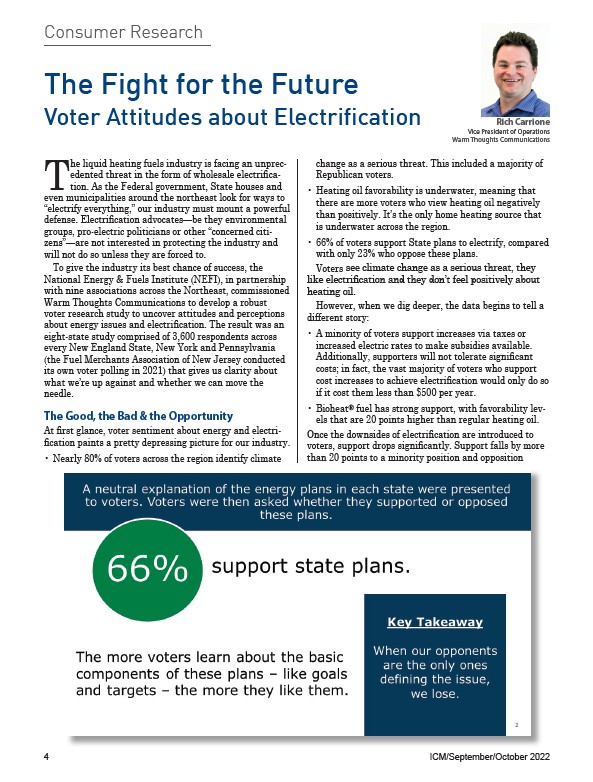
Consumer Research
The Fight for the Future
Voter Attitudes about Electrification
The liquid heating fuels industry is facing an unprecedented
threat in the form of wholesale electrification.
As the Federal government, State houses and
even municipalities around the northeast look for ways to
“electrify everything,” our industry must mount a powerful
defense. Electrification advocates—be they environmental
groups, pro-electric politicians or other “concerned citizens”—
are not interested in protecting the industry and
will not do so unless they are forced to.
To give the industry its best chance of success, the
National Energy & Fuels Institute (NEFI), in partnership
with nine associations across the Northeast, commissioned
Warm Thoughts Communications to develop a robust
voter research study to uncover attitudes and perceptions
about energy issues and electrification. The result was an
eight-state study comprised of 3,600 respondents across
every New England State, New York and Pennsylvania
(the Fuel Merchants Association of New Jersey conducted
its own voter polling in 2021) that gives us clarity about
what we’re up against and whether we can move the
needle.
The Good, the Bad & the Opportunity
At first glance, voter sentiment about energy and electrification
paints a pretty depressing picture for our industry.
• Nearly 80% of voters across the region identify climate
Rich Carrione
Vice President of Operations
Warm Thoughts Communications
change as a serious threat. This included a majority of
Republican voters.
• Heating oil favorability is underwater, meaning that
there are more voters who view heating oil negatively
than positively. It’s the only home heating source that
is underwater across the region.
• 66% of voters support State plans to electrify, compared
with only 23% who oppose these plans.
Voters see climate change as a serious threat, they
like electrification and they don’t feel positively about
heating oil.
However, when we dig deeper, the data begins to tell a
different story:
• A minority of voters support increases via taxes or
increased electric rates to make subsidies available.
Additionally, supporters will not tolerate significant
costs; in fact, the vast majority of voters who support
cost increases to achieve electrification would only do so
if it cost them less than $500 per year.
• Bioheat® fuel has strong support, with favorability levels
that are 20 points higher than regular heating oil.
Once the downsides of electrification are introduced to
voters, support drops significantly. Support falls by more
than 20 points to a minority position and opposition
4 ICM/September/October 2022